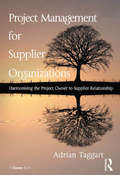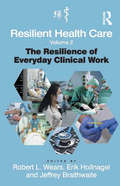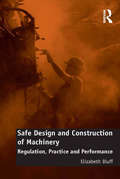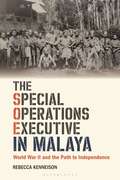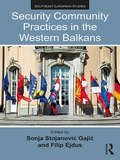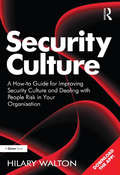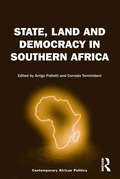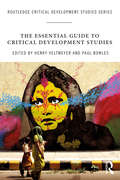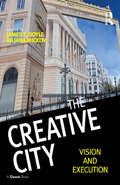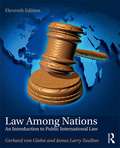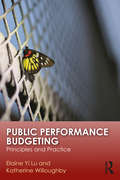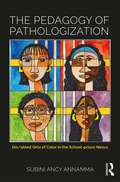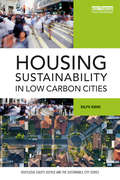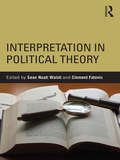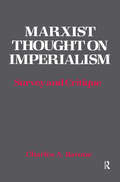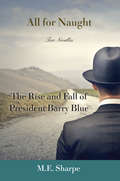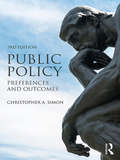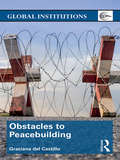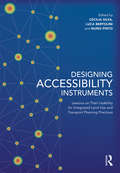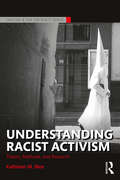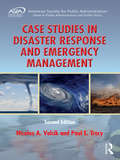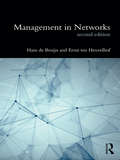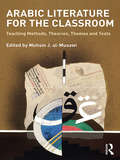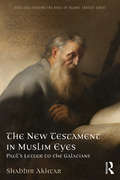- Table View
- List View
Project Management for Supplier Organizations: Harmonising the Project Owner to Supplier Relationship
by Adrian TaggartConventionally, the literature on project management presents the story from the project client, or Owner’s, perspective. Project Management for Supplier Organizations turns this on its head and explores the challenges and remedies from the perspective of the vendors providing the necessary goods and services to a project. It explains the likely impact on the structure, culture, and procedures of Suppliers and identifies the additional competences they may require. It offers new insights, frameworks and models, in particular a new Supplier Organization’s Project Lifecycle Model, that integrate the role of the Supplier as a member of the Owner’s project team with their own necessary commercial activities such as marketing and selling. For Suppliers, this unlocks the contents of the various Bodies of Knowledge, by showing how and where the tools and techniques of project management apply to their particular role. The text explores in some detail the shared and divergent interests of Suppliers and Owners and shows how a well thought-out and carefully executed procurement process maximises the former and diminishes the latter. Such an insight is equally valuable for any Owner Organization. Adrian Taggart’s book provides a refreshing and essential perspective. For Suppliers managing their role in a project, it offers a real insight and an urgent set of priorities. For Owners it shows how best they can work with their suppliers to mutual benefit.
Resilient Health Care, Volume 2: The Resilience of Everyday Clinical Work (Ashgate Studies in Resilience Engineering)
by Erik Hollnagel Robert L. WearsHealth systems everywhere are expected to meet increasing public and political demands for accessible, high-quality care. Policy-makers, managers, and clinicians use their best efforts to improve efficiency, safety, quality, and economic viability. One solution has been to mimic approaches that have been shown to work in other domains, such as quality management, lean production, and high reliability. In the enthusiasm for such solutions, scant attention has been paid to the fact that health care as a multifaceted system differs significantly from most traditional industries. Solutions based on linear thinking in engineered systems do not work well in complicated, multi-stakeholder non-engineered systems, of which health care is a leading example. A prerequisite for improving health care and making it more resilient is that the nature of everyday clinical work be well understood. Yet the focus of the majority of policy or management solutions, as well as that of accreditation and regulation, is work as it ought to be (also known as ’work-as-imagined’). The aim of policy-makers and managers, whether the priority is safety, quality, or efficiency, is therefore to make everyday clinical work - or work-as-done - comply with work-as-imagined. This fails to recognise that this normative conception of work is often oversimplified, incomplete, and outdated. There is therefore an urgent need to better understand everyday clinical work as it is done. Despite the common focus on deviations and failures, it is undeniable that clinical work goes right far more often than it goes wrong, and that we only can make it better if we understand how this happens. This second volume of Resilient Health Care continues the line of thinking of the first book, but takes it further through a range of chapters from leading international thinkers on resilience and health care. Where the first book provided the rationale and basic concepts of RHC, the Resilience of Everyday Clinical Work b
Safe Design and Construction of Machinery: Regulation, Practice and Performance
by Elizabeth BluffThe origin of this book is the compelling evidence that a high proportion of machinery-related deaths and injuries are attributable to genuine and serious risks originating within machine design and construction. This trend continues despite significant legal obligations, notably the European regulatory regime giving effect to the Machinery Directive (among others), and a substantial body of specialist knowledge originating in the disciplines of human factors and safety engineering. Grounded in empirical research with machinery manufacturers, this book aims to elucidate the factors and processes shaping firms’ performance for machinery safety, and considers their compatibility with legal obligations. Through a unique blending of rich empirical data coupled with safety, human factors, socio-legal and learning scholarship, the book provides both a nuanced account of firms’ performance for machinery safety, and makes conceptual and theoretical contributions to understanding and explaining their performance. Specifically, the book elucidates the role of knowledge and motivational factors - and how these are constituted - in shaping firms’ performance. It reveals the multiple state and non-state influences that create plural responses among manufacturing firms, which typically operate in supply chains and networks, and often globally. These insights provide the foundations to enhance regulatory design, and the book’s conclusion recommends some innovative directions for regulatory interventions to sustain the safe design and construction of machinery.
The Special Operations Executive in Malaya: World War II and the Path to Independence
by Rebecca KenneisonDuring World War II, agents of the Special Operations Executive (SOE) infiltrated Japanese-occupied Malaya. There they worked with Malayan guerrilla groups, including the communist-sponsored Malayan Peoples Anti-Japanese Army (MPAJA), regarded as the precursor of the communist insurgent army of the Malayan Emergency. This book traces the development of SOE's Malayan operations, and analyses the interactions between SOE and the various guerrilla groups. It explores the reasons for and the extent of Malay disillusionment with Japanese rule, and demonstrates how guerrilla service acted as a training ground for some later Malay leaders of the independent nation. However, the reports written about the MPAJA by SOE operatives just after the war failed to draw out the likely future threat posed by the communists to the returning colonial administration. Rebecca Kenneison shows that the British possessed a wealth of local information, but failed to convert it into active intelligence in the period prior to the Malayan Emergency. In doing so she provides new insights into the impact of SOE on Malayan politics, the nature of Malayan communism's challenge to colonial rule, and British post-war intelligence in Malaya.
The Special Operations Executive in Malaya: World War II and the Path to Independence
by Rebecca KenneisonDuring World War II, agents of the Special Operations Executive (SOE) infiltrated Japanese-occupied Malaya. There they worked with Malayan guerrilla groups, including the communist-sponsored Malayan Peoples Anti-Japanese Army (MPAJA), regarded as the precursor of the communist insurgent army of the Malayan Emergency. This book traces the development of SOE's Malayan operations, and analyses the interactions between SOE and the various guerrilla groups. It explores the reasons for and the extent of Malay disillusionment with Japanese rule, and demonstrates how guerrilla service acted as a training ground for some later Malay leaders of the independent nation. However, the reports written about the MPAJA by SOE operatives just after the war failed to draw out the likely future threat posed by the communists to the returning colonial administration. Rebecca Kenneison shows that the British possessed a wealth of local information, but failed to convert it into active intelligence in the period prior to the Malayan Emergency. In doing so she provides new insights into the impact of SOE on Malayan politics, the nature of Malayan communism's challenge to colonial rule, and British post-war intelligence in Malaya.
Security Community Practices in the Western Balkans (Southeast European Studies)
by Sonja Stojanović Gajić Filip EjdusIn the early 1990s, the Western Balkans were the scene of prolonged and bloody inter-ethnic wars. Numerous issues remain unresolved; Bosnia is a dysfunctional state; Kosovo a disputed territory; Macedonia a fragile republic, however, it is hard now to imagine the renewal of inter-state armed conflict. Investigating the causes and mechanisms driving peaceful transformation in the Balkans, this book examines developments in the region and contributes to discussions on security community building. Focusing on how different professional communities work together in the creation of regional peace and security, it sheds new light on how diplomats, policemen, soldiers and others brought about the transformation from conflict to peace through their everyday practices. Conducted collaboratively by a research community based within the region, this volume will be highly relevant to scholars and researchers studying the Balkans, regional security, security communities and policymakers.
Security Culture: A How-to Guide for Improving Security Culture and Dealing with People Risk in Your Organisation
by Hilary WaltonSecurity Culture starts from the premise that, even with good technical tools and security processes, an organisation is still vulnerable without a strong culture and a resilient set of behaviours in relation to people risk. Hilary Walton combines her research and her unique work portfolio to provide proven security culture strategies with practical advice on their implementation. And she does so across the board: from management buy-in, employee development and motivation, right through to effective metrics for security culture activities. There is still relatively little integrated and structured advice on how you can embed security in the culture of your organisation. Hilary Walton draws all the best ideas together, including a blend of psychology, risk and security, to offer a security culture interventions toolkit from which you can pick and choose as you design your security culture programme - whether in private or public settings. Applying the techniques included in Security Culture will enable you to introduce or enhance a culture in which security messages stick, employees comply with policies, security complacency is challenged, and managers and employees understand the significance of this critically important, business-as-usual, function.
State, Land and Democracy in Southern Africa (Contemporary African Politics)
by Arrigo Pallotti Corrado TornimbeniEach country in southern Africa has a unique history but in all of them socio-economic inequalities and high poverty levels weaken the governments’ legitimacy and represent a challenge to models of economic development. One key issue appears to be the solution of the land question. This vital concern affects both citizenship and democracy in the political systems of the region, yet no government has shown the capacity or commitment to solve it. In this volume leading European, American and African scholars explore in detail the relationship between state, land and democracy. They examine the historical background of asset allocation and its impact on questions of nationality, the definition of citizenship, human rights and the current political and economic processes in southern Africa.
The Essential Guide to Critical Development Studies (Routledge Critical Development Studies)
by Henry Veltmeyer Paul BowlesIn recent years, much mainstream development discourse has sought to co-opt and neutralize key concepts relating to empowerment, participation, gender, sustainability and inclusivity in order to serve a market-driven, neoliberal agenda. Critical development studies now play a crucial role in combatting this by analyzing the systemic changes needed to transform the current world to one where economic and social justice and environmental integrity prevail.The Essential Guide to Critical Development Studies takes as its starting point the multiple crises – economic, political, social and environmental – of the dominant current global capitalist system. The chapters collectively document and analyze these crises and the need to find alternatives to the system(s) that generate them. To do so, analyses of class, gender and empire are placed at the centre of discussion, in contrast to markets, liberalization and convergence, which characterize mainstream development discourse. Each contributor supplements their overview with a guide to the critical development studies literature on the topic, thereby providing scholars and students not only with a precis of the key issues, but also a signpost to further readings. This is an important resource for academics, researchers, policymakers and professionals in the areas of development studies, political science, sociology, economics, gender studies, history, anthropology, agrarian studies, international relations and international political economy.
The Creative City: Vision and Execution
by James E. Doyle Biljana MickovThe Creative City: Vision and Execution, edited by James E. Doyle and Biljana Mickov, challenges the popular understanding of the Creative City, by bridging the gap between the Creative City as concept and the Creative City as practice and, in so doing, provides a contemporary template for policy makers, city planners, and citizens alike. The book will offer researchers and pragmatists a series of real-life examples of successful cultural and creative practice throughout Europe, reflecting on the analysis and thinking that forms our contemporary understanding of the creative city. It will examine and explain the changes to the concept of the ’creative city’, explore its connectivity to the cultural sector as well as other sectors and practices across Europe and will serve to illustrate the perspectives of Cultural Managers, Educators, Professionals and Researchers from the creative sector in Dublin and Europe. This book will present the reader, and the cultural sector at large, with a new reality based on the quality of contemporary creative practice. Doyle and Mickov address cultural trends such as sustainability and social networking and how they value-impact our attitudes towards culture and the creative city By recognizing that we live in a time of rapid change, which affects all systems, financial models, resources, the economy and technology, we also recognize that the creative process is at the heart of our responses to these changes.
Law Among Nations: An Introduction to Public International Law
by Gerhard von Glahn James Larry TaulbeeOffering a more accessible alternative to casebooks and historical commentaries, Law Among Nations explains issues of international law by tracing the field's development and stressing key principles, processes, and landmark cases. This comprehensive text eliminates the need for multiple books by combining discussions of theory and state practice with excerpts from landmark cases. The book has been updated in light of the continuing revolution in communication technology, the dense web of linkages between countries that involve individuals and bodies both formal and informal; and covers important and controversial areas such as human rights, the environment, and issues associated with the use of force. Renowned for its rigorous approach and clear explanations, Law Among Nations remains the gold standard for undergraduate introductions to international law. New to the Eleventh Edition Added or expanded coverage of timely issues in international law: Drones and their use in the air and in space Immigration Islamic views of international law Inviolability and the difference between diplomatic immunity and sovereignty, in light of the Benghazi attack Thoroughly rewritten chapters in areas of great change: International criminal law Just war and war crime law New cases, statutes, and treaties on many subjects
Public Performance Budgeting: Principles and Practice
by Elaine Yi Lu Katherine WilloughbyPerformance budgeting involves costs, from the drafting and passage of legal foundations, and the political capital and will to implement it, to training personnel to create a performance-oriented culture, and information technology requirements to track performance. Through comprehensive examination of performance budgeting laws, in-depth interviews of those practicing in government agencies, and quantitative survey analysis, Public Performance Budgeting examines the influence of performance measurement and evaluation on all phases of the budgeting process. Lu and Willoughby present original research and case studies to explore how performance is linked to public budgets and government results, its impacts on budgeting systems, and possible unintended consequences. A summary assessment of how performance measurement could and should play a role in furthering performance budgeting is explored in a concluding chapter. The first of its kind to spotlight budget practice through the lens of juvenile justice, this book is required reading for all those studying public budgeting, management, and policy.
The Pedagogy of Pathologization: Dis/abled Girls of Color in the School-prison Nexus
by Subini Ancy AnnammaWINNER OF THE 2018 NATIONAL WOMEN'S STUDIES ASSOCIATION ALISON PIEPMEIER BOOK PRIZE Linking powerful first-person narratives with structural analysis, The Pedagogy of Pathologization explores the construction of criminal identities in schools via the intersections of race, disability, and gender. amid the prevalence of targeted mass incarceration. Focusing uniquely on the pathologization of female students of color, whose voices are frequently engulfed by labels of deviance and disability, a distinct and underrepresented experience of the school-to-prison pipeline is detailed through original qualitative methods rooted in authentic narratives. The book’s DisCrit framework, grounded in interdisciplinary research, draws on scholarship from critical race theory, disability studies, education, women’s and girl’s studies, legal studies, and more.
Housing Sustainability in Low Carbon Cities (Routledge Equity, Justice and the Sustainable City series)
by Ralph HorneHousing affordability, urban development and climate change responses are great challenges that are intertwined, yet the conceptual and policy links between them remain under-developed. Housing Sustainability in Low Carbon Cities addresses this gap by developing an interdisciplinary approach to urban decarbonisation, drawing upon more established, yet quite distinctive, fields of built environment policy and design, housing, and studies of social and economic change. Through this approach, policy and practices of housing affordability, equity, energy efficiency, resilience and renewables are critiqued and alternatives are presented. Drawing upon international case studies, this book provides a unique contribution to interdisciplinary urban and housing studies, discourses and practices in an era of climate change. This book is recommended reading on higher level undergraduate and taught postgraduate courses in architecture, urban studies, planning, built environment, geography and urban studies. It will also be directly valuable to housing and urban policy makers and sustainability practitioners.
Interpretation in Political Theory
by Clement Fatovic Sean Noah WalshTheorists interested in learning more about any given interpretive approach are often required to navigate a dizzying array of sources, with no clear sense of where to begin. The prose of many primary sources is often steeped in dense and technical argot that novices find intimidating or even impenetrable. Interpretation in Political Theory provide students of political theory a single introductory reference guide to major approaches to interpretation available in the field today. Comprehensive and clearly written, the book includes: A historical and theoretical overview that situates the practice of interpretation within the development of political theory in the twentieth century. Chapters on Straussian esotericism, historical approaches within the Cambridge School of interpretation, materialist approaches associated with Marxism, the critical approaches associated with varieties of feminism, Greimassian semiotics, Foucaultian genealogy, the negative dialectics of Theodor Adorno, deconstruction as exemplified by Jacques Derrida and Paul de Man, and Lacanian psychoanalysis. An exposition of the theoretical and disciplinary background of each approach, the tools and techniques of interpretation it uses, its assumptions about what counts as a relevant text in political theory, and what it considers to be the purpose or objective of reading in political theory. A reading of Thomas Hobbes’s Leviathan to illustrate how each approach can be applied in practice. A list of suggestions for further reading that will guide those interested in pursuing more advanced study. An invaluable textbook for advanced undergraduates, graduate students, and even seasoned scholars of political theory interested in learning more about different interpretive approaches.
Marxist Thought on Imperialism: Survey and Critique
by Charles A. BaroneFirst Published in 2015. Routledge is an imprint of Taylor & Francis, an Informa company.
All for Naught: The Rise and Fall of President Barry Blue: Two Novellas
by M. E. SharpeAll for Naught tells the story of Richard Melmont, a billionaire many times over. His wife Maria, daughter Barbara, and son Daniel are appalled by his cutthroat methods and even more appalled by the weapons system he is developing. Is he deliberately deceiving government officials, bankers, and the general public, or is he deceiving himself? In The Rise and Fall of President Barry Blue, an experienced White House correspondent is trying to sort through contradictory insider accounts to get a true picture of an elusive president.
Public Policy: Preferences and Outcomes
by Christopher A. SimonNow in a thoroughly revised third edition, Public Policy: Preferences and Outcomes is designed to help students enrolled in a public policy course discuss policy issues and understand the ways in which public policy is grounded in normative theory. This approachable book examines the role of political theory in the governance process and the effect of public opinion on policy priorities and government. It introduces students to the tools of policy analysis and the most up to date policy theories in conceptualizing public policy in several major policy areas. New to this edition: A thoroughly revised and updated chapter on public policy models, including new sections on the importance of science, pluralism, institutional analysis and development, multiple streams, the advocacy coalition framework, the punctuated equilibrium framework, policy diffusion, and the constructivist approach. New sections on health policy, welfare economics and the public good, the nuclear arms race, the War on Terrorism, the Quadrennial Defense Review, contemporary policing techniques and issues, and renewable energy. Restructured and rewritten sections on social policy and equality that includes sections on employment, LGBTQ rights and same sex marriage, the legalization of marijuana, and income inequality. Assuming no prior knowledge of the subject, and offering instructors a variety of ways to tailor the book to their classroom setting and course priorities, Public Policy: Preferences and Outcomes, 3e is a highly flexible and effective teaching resource for introductory public policy courses at the undergraduate level and also serves as an ideal refresher book for students at the graduate level.
Obstacles to Peacebuilding (Global Institutions)
by Graciana del CastilloCombining the insights of a seasoned practitioner with the academic rigor of a meticulous policy and risk analyst, del Castillo discusses the major obstacles to peacebuilding that need to be removed before war-torn countries can move towards peace, stability, and prosperity. As Secretary-General António Guterres assumes leadership in January 2017, a top priority must be to address the bleak peacebuilding record where over half of the countries under UN watch relapse back into conflict within a decade. While policy debate and the academic literature have focused on the security, political, and social aspects of the war-to-peace transition, this book focuses on "the economic transition"—that is, "economic reconstruction" or "the political economy of peace"—which, in the author’s view, is the much-neglected aspect of peacebuilding. The book argues that rebuilding war-torn states effectively has acquired a new sense of urgency since extremist groups increasingly recruit people by providing jobs and services to those deprived of them due to government and economic failures. Based on past lessons and best practices of the last quarter of a century, the author makes recommendations to move forward and improve the record. It will be of great use to students and scholars of peacebuilding, as well as policymakers in national governments, donor countries and international organizations involved in peacebuilding, statebuilding, and development.
Designing Accessibility Instruments: Lessons on Their Usability for Integrated Land Use and Transport Planning Practices
by Cecilia Silva Nuno Pinto Luca BertoliniThe integration of land use and transport planning is key to making cities sustainable and liveable. Accessibility can provide an effective framework for this integration. However, today there is a significant gap between the advances in scientific knowledge on accessibility and its effective application in planning practice. In order to close this gap, Designing Accessibility Instruments introduces a novel methodology for the joint assessment and development of accessibility instruments by researchers and practitioners. The book: provides a theoretical and professional analysis of the main concepts behind the definition, use and measurement of accessibility; undertakes a comprehensive inventory and critical analysis of accessibility instruments, focusing on the bottlenecks in their transposition to planning practice; introduces and applies a novel methodology for the assessment and improvement of the practical use and usefulness of accessibility instruments; presents six in-depth illustrative case study applications of the methodology, representing a range of cities with different geographical and institutional settings, and different levels of urban and transport planning integration. The book is supported by a companion website – www.accessibilityplanning.eu – which extrapolates its content to a broader scope and keeps it updated and valid with new iterations of the methodology and further advances on the initial and new case studies.
Understanding Racist Activism: Theory, Methods, and Research (Routledge Studies in Fascism and the Far Right)
by Kathleen M. BleeWhite supremacist groups are highly secretive, so their public propaganda tells us little about their operations or the people they attract. To understand the world of organized racism it is necessary to study it from the inside by talking to their members and observing their groups. Doing so reveals a disturbing picture of how fairly ordinary white people learn to embrace the vicious ideas and dangerous agendas of white supremacism. This book takes the reader inside organized racism, revealing the kind of women and men who join groups, such as the Ku Klux Klan or neo-Nazi skinheads, and what they do in those groups. The volume collects significant published works from renowned scholar Kathleen M. Blee's work on racist activism, alongside new essays on the theories, methods, and approaches of studying racist activism. Discussing topics such as emotional issues in research, the place of violence and hate in white supremacism, and how women are involved in racial terrorism, Blee makes use of a range of sources, including oral histories, ethnographic observations, and interviews, to shape her findings. Written by the pioneer and leading scholar of women in racist activism, this volume is essential reading for students, scholars, and general readers interested in the areas of social movements, politics, race studies, and American history.
Case Studies in Disaster Response and Emergency Management (ASPA Series in Public Administration and Public Policy #169)
by Nicolas A. Valcik Paul E. TracyDesigned to enable practitioners and students to evaluate a variety of real-life emergencies from every angle, this new edition of Case Studies in Disaster Response and Emergency Management provides clear, thorough, step-by-step descriptions of more than 50 major disasters or emergencies. Arranged chronologically, the case studies involve incidents from around the globe, with topics including natural disasters, industrial accidents, epidemics, and terrorist attacks. A series of questions throughout each case study encourages the reader to think critically about the problem at hand, to select a course of action, and to then see the results of the decisions that were made. This hands-on approach invites practitioners and students to apply learned theoretical emergency management techniques in a safe test environment. Case Studies in Disaster Response and Emergency Management, 2e provides readers with the most modern and current case studies in disaster response and emergency management and can be used in group project settings, as individual homework assignments in training courses for first responders, law enforcement, and government employees, or to complement existing emergency management textbooks in Public Administration, Public Management, and Public Affairs programs.
Management in Networks: On Multi-actor Decision Making
by Hans de Bruijn Ernst Ten HeuvelhofGetting what you want – even if you are the boss – isn’t always easy. Almost every organization, big or small, works among a network of competing interests. Whether it’s governments pushing through policies, companies trying to increase profits, or even families deciding where to move house, rarely can decisions be made in isolation from competing interests both within the organization and outside it. In this accessible and straightforward account, Hans de Bruijn and Ernst ten Heuvelhof cast light on multi-stakeholder decision-making. Using plain language, they reveal the nuts and bolts of decision-making within the numerous dilemmas and tensions at work. Drawing on a diverse range of illustrative examples throughout, their perceptive analysis examines how different interests can either support or block change, and the strategies available for managing a variety of stakeholders. The second edition of Management in Networks incorporates a wider spread of international cases, a new chapter giving an overview of different network types, and a new chapter looking at digital governance and the impact of big data on networks. This insightful text is invaluable reading for students of management and organizational studies, plus practitioners – or actors – operating in a range of contexts.
Arabic Literature for the Classroom: Teaching Methods, Theories, Themes and Texts
by Mushin J al-MusawiArabic Literature for the Classroom argues for a more visible presence of Arabic within the humanities and social sciences, stressing the need to make Arabic literature available as a world literature, without damaging its own distinctive characteristics. The nineteen chapters which make up this book broach theoretical and methodical cultural concerns in teaching literatures from non-American cultures, along with issues of cross-cultural communication, cultural competency and translation. While some chapters bring out the fascinating and ever tantalizing connections between Arabic and the literatures of medieval Europe, others employ specific approaches to teaching particular texts, potential methodologies, themes and a variety of topics that can place Arabic widely in a vast swathe of academic application and learning. Topics that are explored include gender, race, class, trauma, exile, dislocation, love, rape, humor, and cinema, as well as issues that relate to writers and poets, women’s writing and the so called nahdah (revival) movement in the 19th Century. The comparative framework and multi-disciplinary approach means that this book injects new life into the field of Arabic Literature. It will therefore be an essential resource for students, scholars and teachers of Arabic Literature, as well as for anyone with an interest in learning more about Arabic culture.
The New Testament in Muslim Eyes: Paul's Letter to the Galatians (Routledge Reading the Bible in Islamic Context Series)
by Shabbir AkhtarThis book explores Christian origins by examining a key New Testament epistle, Paul’s letter to the Galatian churches, seen by Christians as the charter of Christian liberty from the inherited Jewish law. The New Testament in Muslim Eyes provides a close textual commentary on perhaps the earliest declaration of Paul’s apostleship and of his undying commitment to the risen Christ. It notes the subtleties of the Greek original against the backdrop of an exciting glimpse of Quranic Arabic parallels and differences. It asks: Does Paul qualify as a prophet of Allah (God)? The thoughts of Paul are assessed by examining his claims against the background of Islam’s rival views of Abraham and his legacy. The Arabic Quran framed and inspired the life of the Arab Apostle, Muhammad, who was sent, according to Islam, to all humanity, Jewish and Gentile alike. Pauline themes are set in dialectical tension with the claims of the Quran. Akhtar compares and contrasts the two rival faiths with regard to: the resources of human nature, the salvation of the sinner, and the status of the works of the law. Both Christians and Muslims concur on the need for God’s grace, an essential condition of success in the life of faith. The core Pauline Christian doctrine of justification by faith alone is scrutinised and assessed from a variety of non-Christian, especially Islamic, stances. Providing an Islamic view of Christian origins, this book helps to build bridges between the two religions. It will be a valuable resource to students and scholars of Biblical Studies, Islamic Studies, and the Philosophy of Religion.
